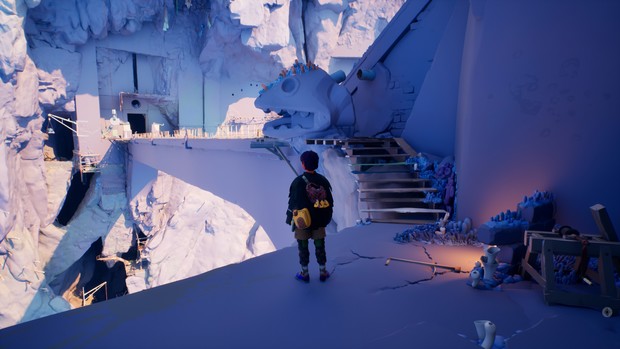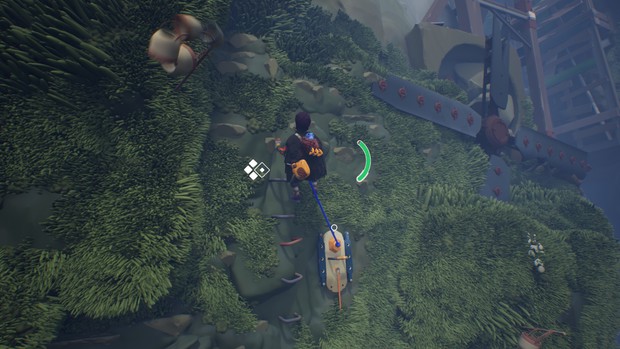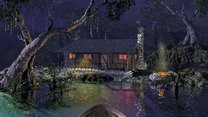Jusant review

- 0 Comments
Its footing isn’t always sure, but Don’t Nod’s gorgeous climbing adventure has more ups than downs
Note: Since time of writing, an update has enabled new features simplifying environmental interactions. This review is based solely on the original version of the game.
Rock climbing is a very adventurous activity, but it’s not a very adventure game-like one. After all, outside of King’s Quest VI, there aren’t a lot of puzzles, NPCs or inventory items tucked into crevices in the middle of a high-altitude cliff face. Instead there’s a whole lot of painstaking footwork, extraordinary demands of strength and fitness, and death-defying courage involved. At least, so I hear. Possessing pretty much none of those qualities myself, the closest I’ll ever get to climbing a mountain first-hand is playing Jusant. Don’t Nod’s unique new game essentially takes the notion of the puzzle-platformer and turns it on its head. Instead of going sideways, you go up, up, and up, enduring all the trials and tribulations involved in a vertical ascent rather than a horizontal one. The end result can be a little uneven, with touchy controls at inopportune times and a backstory that’s overly reliant on telling rather than showing, but it’s a beautiful, thoughtful journey that can feel genuinely uplifting when everything clicks.
I said “mountain” earlier but the one here is known by the (former) locals as a tower – a monumental, cylindrically shaped natural stone structure that stretches literally sky-high, far above the clouds. Incredibly, a resilient race of civilized people used to live on various levels of this tower, dwelling mostly in inner caves, tunnels and caverns carved out into familiar social facilities like cafes, workshops, and homes. What’s more incredible, however, is that this tower used to be almost entirely submerged underwater. “Jusant” is a French word meaning “receding tide,” and that’s what happened here, at cataclysmic proportions. One day the oceans began receding, the rains stopped, and they simply never returned, leaving the residents of the tower struggling to survive, moving to lower and lower elevations to carry on, before finally being forced to disperse to the lifeless desert at its base.
If you’re concerned that’s a spoiler, rest assured that it quickly becomes apparent what’s happened. There are shipwrecks dotting the arid “Great Plains” right at the start of the game, and telltale signs of abandoned fishing settlements and low-tide environments resembling a dried-up seabed everywhere you look – only in this case, low tide has now permanently turned into no tide. And yet life has evolved in this waterless world, with luminescent mushroom-like plant life and colourful marine invertebrates instinctively and excitably reacting to your presence. There are other crawly critters living here as well, which would surely freak you out in real life but are no threat and seem right at home here. Some even have an important role in your progress.

You, of course, need to start at the bottom. From the endless desert expanse you emerge – a young man; still just a boy, really – arriving at the tower with clear designs on reaching the top. Why is never explained, and the protagonist never speaks. You’re accompanied by an adorable little blue critter whose only real distinguishing features are his hairless body, stubby legs, large eyes, and heartwarming (or heartbreaking) coos emanating from the backpack in which he’s carried. (for convenience I’ll refer to him as male, though that’s never determined, and I came to call him Blue; it’s a little on the nose, if Blue had a nose, but it fits.) Together you embark on an epic climb with nothing but a whole lot of guts and some rope, carabiners and pitons to keep you aloft on the treacherous rock surface.
I love games that make me feel like a daredevil in ways I’d never be in real life, so I thought I’d be in my element in Jusant. And to an extent I was: The game has you simulating hand-over-hand climbing movements to propel yourself between grippable ledges, with other controls for repelling up and down from a secure point. You can place secondary pitons (you’ll automatically secure the first when you begin any individual climb), turn the odd valve, jump and double jump, and occasionally do wall runs and rope swings to reach otherwise inaccessible destinations. And really that’s about it. Your interactions are limited throughout the entire journey; unlike most games, you never upgrade your own abilities, so instead you must find ways to manipulate and utilize the natural environment within your limited means.
That’s where Blue comes in. Apparently the little guy has a kind of mystical connection to the tower, so you can direct him to send out an impulse that awakens dormant plant life to create new avenues of exploration, whether giant vines that spring to new heights, or mini buds that sprout in climbable formations along a wall. You can only do this at pre-set points, however, so you must keep an eye out for the appropriate flora. Some of the fauna here has its own uses, like the slow-moving “pebbles” that skitter across walls like worker ants and allow you to hitch a ride until you tire them out, or swarms of firefly-like “sparks” than can lift you a short distance. Jusant doesn’t have many tricks up its sleeve, but little additions like these introduce just enough variation to keep the experience relatively fresh.

Unfortunately, the controls aren’t nearly as tight or forgiving as they could have been – in my opinion should have been. A gamepad is recommended, and I strongly second that suggestion, though you can play with a keyboard and mouse as well. But even with a controller, things can get finicky at the most inopportune times. I’m used to impossible-looking leaps in games like Tomb Raider or Assassin’s Creed, where just when I think I’ve fallen short or misjudged a distance, the hero will miraculously grab that ledge seemingly just out of reach. Not so here. You need to be precise, and even then the game may be reluctant to respond, particularly when trying to angle to one side. All too often I’d miss sticking a landing even though I was right there, plummeting as far as my rope would take me and forced to try again.
I get that rock climbing is hard, and a certain degree of precision may have been entirely by design to better duplicate a challenging physical activity. But lest you think I merely stink at doing so virtually, there are specific points laid out during a climb to place new primary pitons, and on far too many occasions I’d be positioned directly on top of or immediately beside one with no wiggle room at all, and still the button prompt signifying an available interaction refused to appear. Now, the flip side to how punishing the controls can be is that you can’t die. Not even if you try. (And I did, just of out of curiosity, not because the game made me suicidal.) Since you’re always secured by a rope, you can never drop all the way to your doom. It’s important, then, to remember to place secondary pitons along the way. On-screen instructions pop up to remind you occasionally, and yet I often forgot anyway, so learn from my mistakes: the higher you climb (without pitons), the farther you fall to try again.
Not dying isn’t the same as not exhausting yourself, mind you. Gravity is not your friend here, so during a climb a stamina meter is displayed that gradually depletes unless you rest. (Surprisingly, you can “rest” even while clinging with one hand to a small ledge.) More exertion means greater expenditure – a double jump uses more energy than simple climbs – and gradually the top end of the meter shrinks too, allowing you to recuperate less fully. Run out of stamina completely and you’ll fall, and the only way to fully revive is to find solid ground or reach one of those stubborn primary piton points. For the most part this is entirely manageable, but it gets a lot trickier outside in the enervating sun, or when fighting against intense wind, and it’s problematic if you find yourself trying desperately to salvage your last bit of available stamina.

While much of Jusant’s focus is on climbing, you don’t spend all your time moving vertically. Each of the game’s six chapters has its own internal tower section to explore, although there’s lots of climbing to do inside as well. It’s here that you’ll pick up little bits of lore about the former residents, but I was disappointed that so little of it was represented visually. Other than “someone used to live here, and their lives were based around the sea,” there isn’t much to decipher from the environmental storytelling. There are no real signs of strife or disarray to depict the life-altering upheaval these people must have faced. Instead, all the narrative bits are conveyed through scattered letters and documents, offering fragmented glimpses of life in the tower.
One set of letters is from a woman named Bianca, an ambitious lower-level-dweller who joined an expedition to reach the top of the tower, while the others are from various sources written at different points of the ocean receding. What’s interesting about the latter is that the higher you go, and the later you find them, the earlier the documents are dated chronologically, so you read them knowing the further devastation lying before them while they still cling to the hope that the worst is behind them. It’s engaging enough insight, but continually stopping to read yet another note seems a little at odds with an epic adventure based entirely on movement. Eventually I stopped and just read them en masse from the main menu later.
There aren’t any puzzles to solve either, which seems like a missed opportunity. There are countless examples of games with ancient civilizations with broken-down equipment to restore, and Jusant seemed like a prime candidate for some of that. But other than opening a couple doors, there’s nothing much to do here except pass through. In fact, you’ll encounter plenty of helpful scaffolding, and the occasional mechanical lift or zipline you ride are still in perfectly functional order when you find them.

Of course, navigating the world of Jusant could be considered a giant puzzle in itself. But here too, the flat-level parts are far less fun than going up. The inner levels can be twisty and maze-like, with little direction to help you know where to go. Blue can be induced to offer a hint, but all he’ll do (if he shows anything) is produce an aura in the direction of your next destination, not indicate how to get there through labyrinthine rooms and corridors and various heights. More than once I felt a little lost, but credit to the designers that whenever that happened, I found that if I just kept going, I eventually found my way. I did miss a number of collectibles, however. Along with the documents there are conches with faint echoes of the past to listen to, cairns to build another layer upon, and other goodies that add nothing to the story but are there to taunt completionists. (You can replay any chapter after finishing, with full knowledge of how many of what things you missed the first time.)
Another incentive to get back outside is that the views are so stunning. It’s always the same general rock formation, but each chapter has its own distinct palette, whether cool blues, scorching reds, browns, greens or something in between. Parts of the tower are hot and parched, while others are still surprisingly lush, and one is an almost Vernian canyon filled with floating jellyfish-like creatures that somehow adapted to air. You’ve got your face mashed against a wall a lot, so be sure to stop occasionally and take in the sights. Looking up and down to gauge your progress makes for an interesting change, rather than the more traditional forward and back. My only complaint about the graphics is that it can be hard to discern handholds – not always or even often, but occasionally. As with the controls needing to be precise, here too Jusant is content at times to make your life more difficult than games that highlight their paths more overtly.
With no voice acting and limited ambient sound effects on this solo journey through abandoned locales, this is a rather quiet experience. Even the music remains largely in the background, where it subtly but effectively reinforces an atmosphere of exploration, ranging from haunting organs to melancholy piano, from sci-fi synths to more inspirational violins when the situation warrants.
At one point I had to reload an automatic checkpoint when I got physically stuck in the scenery, but for the most part the production is solid and the pace brisk. I finally reached the top of the tower before the six-hour mark, so it’s not a particularly lengthy journey, but any longer and the formula would start to wear thin. The final sequence adds a new level of challenge – similar but with more restrictions – and though I obviously wouldn’t dare spoil the ending, I will say that it goes a really funky direction (figuratively speaking). While it’s vaguely hinted at in some of the letters and more ornate indigenous-styled cave murals, it still managed to catch me completely off guard. It’s probably not how I would have drawn it up, but it left me feeling satisfied nonetheless.
Final Verdict
I’m really glad I played Jusant. It’s so different than other games that I really looked forward to it, and for the most part I rather enjoyed my time scaling its steep heights. My biggest disappointment is that greatness was within its grasp but – as happened far too often to me on my way up – the designers let it slip through their fingers. More forgiving controls, clearer direction, and a more organic approach to storytelling would have better complemented such a gorgeous world to explore. Nevertheless, the change in perspective adds a welcome new angle – literally – and the “action” element isn’t overly demanding, feeling like a giant environmental puzzle to be solved with a bit more physical exertion than normal, rather than a high-octane race to the top requiring fast reflexes. Throw in a cuddly sidekick (be sure to give him some attention!), some intriguing background lore of a bygone civilization, and a few new gameplay elements along the way, and Jusant’s strengths are more than enough to help it rise above its limitations. It may not be perfect, but it’s one of the increasingly rare games that emphasize gameplay above all else, so it’s a definitely step in the right direction. Onward and upward, Don’t Nod!
Hot take
Though it doesn’t quite reach the heights it aspires to, Jusant is a lovely mountaineering adventure that makes for a refreshing change from the norm in both axis and pace.
Pros
- Progressing vertically makes for a welcome different perspective than usual
- Gorgeous presentation with unique sea-originated settings
- Injects just enough new elements to keep things fairly fresh
- Adorable sidekick becomes integral to success
Cons
- Controls can be needlessly finicky at the worst times
- Storytelling done almost exclusively through written notes
- Vague directional cues in nonlinear inner areas
Jack played Jusant on PC using a review code provided by the game's publisher.










0 Comments
Want to join the discussion? Leave a comment as guest, sign in or register in our forums.
Leave a comment